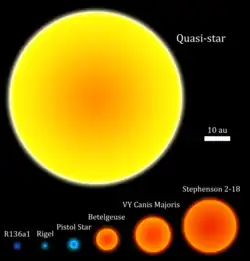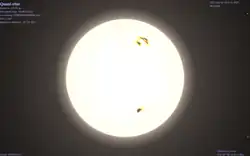Quasi-star


A quasi-star (also called black hole star) is a hypothetical type of extremely large and luminous star that may have existed early in the history of the Universe. Unlike modern stars, which are powered by nuclear fusion in their cores, a quasi-star's energy would come from material falling into a black hole at its core. Due to their immense mass, they would have had a relatively short lifespan of around 7 to 10 million years.
Quasi-stars were first proposed in the 1960s; there has not yet been a confirmed observation, though potential sightings of these objects have been made by the James Webb Space Telescope since it was launched.[1] The study of quasi-stars would provide valuable insight into the early universe, galaxy formation, and the behavior of black holes, namely because they are considered as possible progenitors of the supermassive black holes that formed soon after the Big Bang.[2]
Formation and properties
Formation of quasi-stars could only happen early in the development of the universe before hydrogen and helium were contaminated by heavier elements; thus, they may have been very massive Population III stars.[3] A quasi-star would have resulted from the core of a protostar of at least 1,000 solar masses (2.0×1033 kg) collapsing into a black hole, where the outer layers of the protostar are massive enough to absorb the resulting supernova without being blown away.[4] Quasi-stars may have also formed from dark matter halos drawing in enormous amounts of gas via gravity, which can produce supermassive stars with tens of thousands of solar masses.[5][6] In either case, quasi-stars would have ballooned to enormous sizes, dwarfing the largest known modern stars and approaching the Solar System in size.[1] They are predicted to have had surface temperatures higher than 10,000 K (9,700 °C).[7] At these temperatures, each one would be about as luminous as a small galaxy.[2]
Once the black hole had formed at the core of a new quasi-star, it would continue generating a large amount of radiant energy from the infall of stellar material. This constant outburst of energy would counteract the force of gravity, creating an equilibrium similar to the one that supports modern fusion-based stars.[7] Quasi-stars would have had a short maximum lifespan, approximately 7 to 10 million years,[8] during which the core black hole would have grown to about 1,000–10,000 solar masses (2×1033–2×1034 kg).[2][7]
As a quasi-star cooled over time, its outer envelope would become transparent, until further cooling to a limiting temperature of 4,000 K (3,730 °C).[7] This would mark the end of the quasi-star's life since there is no hydrostatic equilibrium at or below this limiting temperature.[7] It would then dissipate without a supernova, leaving behind an intermediate-mass black hole.[7] These intermediate-mass black holes are theorized as the progenitors of modern supermassive black holes, and would help explain how supermassive black holes formed so early in the history of the universe.
See also
- Accretion (astrophysics) – Accumulation of particles into a massive object by gravitationally attracting more matter
- Accretion disk – Structure formed by diffuse material in orbital motion around a massive central body
- Blitzar – Hypothetical type of neutron star
- Thorne–Żytkow object – Hypothetical hybrid star type
- Neutron star – Collapsed core of a massive star
- Quasar – Active galactic nucleus (AGN) containing a supermassive black hole
- Direct collapse black hole – High-mass black hole seeds
References
- ^ a b Clery, Daniel (29 July 2025). "Early universe's 'little red dots' may be black hole stars".
- ^ a b c Battersby, Stephen (29 November 2007). "Biggest black holes may grow inside 'quasistars'". New Scientist.
- ^ Ball, Warrick H.; Tout, Christopher A.; Żytkow, Anna N.; Eldridge, John J. (1 July 2011). "The structure and evolution of quasi-stars: The structure and evolution of quasi-stars". Monthly Notices of the Royal Astronomical Society. 414 (3): 2751–2762. arXiv:1102.5098. Bibcode:2011MNRAS.414.2751B. doi:10.1111/j.1365-2966.2011.18591.x.
- ^ Ball, Warrick H.; Tout, Christopher A.; Żytkow, Anna N.; Eldridge, John J. (2011). "The structure and evolution of quasi-stars". Monthly Notices of the Royal Astronomical Society. 414 (3): 2751–2762. arXiv:1102.5098. Bibcode:2011MNRAS.414.2751B. doi:10.1111/j.1365-2966.2011.18591.x.
- ^ Saplakoglu, Yasemin (29 September 2017). "Zeroing In on How Supermassive Black Holes Formed". Scientific American. Retrieved 8 April 2019.
- ^ Johnson-Goh, Mara (20 November 2017). "Cooking up supermassive black holes in the early universe". Astronomy.com. Retrieved 8 April 2019.
- ^ a b c d e f Begelman, Mitch; Rossi, Elena; Armitage, Philip (2008). "Quasi-stars: accreting black holes inside massive envelopes". MNRAS. 387 (4): 1649–1659. arXiv:0711.4078. Bibcode:2008MNRAS.387.1649B. doi:10.1111/j.1365-2966.2008.13344.x. S2CID 12044015.
- ^ Schleicher, Dominik R. G.; Palla, Francesco; Ferrara, Andrea; Galli, Daniele; Latif, Muhammad (25 May 2013). "Massive black hole factories: Supermassive and quasi-star formation in primordial halos". Astronomy & Astrophysics. 558: A59. arXiv:1305.5923. Bibcode:2013A&A...558A..59S. doi:10.1051/0004-6361/201321949. S2CID 119197147.
Further reading
- Ball, Warrick H.; Tout, Christopher A.; Żytkow, Anna N.; Eldridge, John J. (2011). "The structure and evolution of quasi-stars". Monthly Notices of the Royal Astronomical Society. 414 (3): 2751–2762. arXiv:1102.5098. Bibcode:2011MNRAS.414.2751B. doi:10.1111/j.1365-2966.2011.18591.x. S2CID 119239346.
- Ball, Warrick H. (2012). "Quasi-stars and the Schönberg-Chandrasekhar limit". arXiv:1207.5972 [astro-ph.SR].
- Czerny, Bozena; Janiuk, Agnieszka; Sikora, Marek; Lasota, Jean-Pierre (2012). "Quasi-Star Jets as Unidentified Gamma-Ray Sources". The Astrophysical Journal. 755 (1): L15. arXiv:1207.1560. Bibcode:2012ApJ...755L..15C. doi:10.1088/2041-8205/755/1/L15. S2CID 113397287.
- Fiacconi, Davide; Rossi, Elena M. (2017). "Light or heavy supermassive black hole seeds: The role of internal rotation in the fate of supermassive stars". Monthly Notices of the Royal Astronomical Society. 464 (2): 2259–2269. arXiv:1604.03936. doi:10.1093/mnras/stw2505.
- Herrington, Nicholas P.; Whalen, Daniel J.; Woods, Tyrone E. (2023). "Modelling supermassive primordial stars with <SCP>mesa</SCP>". Monthly Notices of the Royal Astronomical Society. 521: 463–473. arXiv:2208.00008. doi:10.1093/mnras/stad572.
- Dotan, Calanit; Rossi, Elena M.; Shaviv, Nir J. (2011). "A lower limit on the halo mass to form supermassive black holes". Monthly Notices of the Royal Astronomical Society. 417 (4): 3035–3046. arXiv:1107.3562. Bibcode:2011MNRAS.417.3035D. doi:10.1111/j.1365-2966.2011.19461.x.
External links
- "Quasi-Stars: Black Holes at the Core of the Universe's Largest Stars". 16 May 2020.
- Kurzgesagt (15 December 2022), Black Hole Star – The Star That Shouldn't Exist
